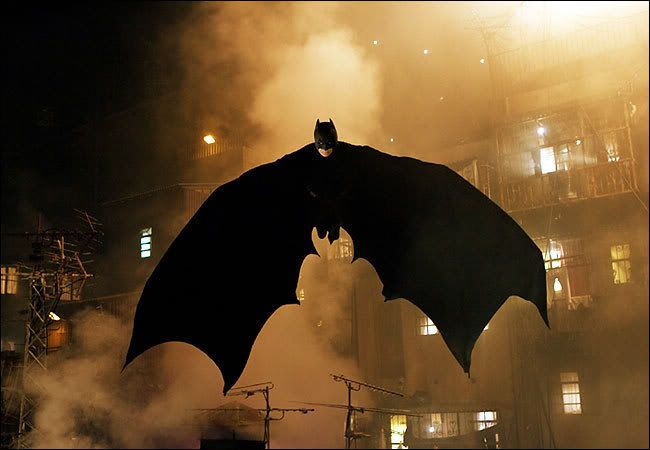
As "Batman Begins" is described as an attempt to revitalize the franchise, the story centers on the Batman origin, the process of how young Bruce Wayne is transformed into a seemingly super natural force of justice. Invariably super hero origin stories are about a process of initiation. It is at its core the Hero's Journey after all. Nolan and Company revel in this structure, and we find esoteric symbolism supporting the theme at practically every Turn.
There are many places we might expect a gothic, high fantasy melodrama to open. It is unexpected maybe that "Batman Begins" starts in a Garden. Unexpected but fully appropriate. This is the childhood garden of Bruce Wayne and Rachel Dawes. The sequence is brief, the children run through the garden in innocent abandon, stopping at a Green House. The Green House symbol works on many levels. A Green House is a Temple of the Sun, its function emphasizes the process of growth and development. And there's the pun of its name, the Green House, a locale for Green Language speakers. If we think about the nature of a green house to produce growth through solar enlightenment, and keep in mind its glass walls, we can easily see how it can work as an emblem of the Invisible College, especially placed subtly as a starting point for a character that is fundamentally Dionysian in nature. Related to this is the significance of the Garden as a starting point in a story following the model of Persephone.
Also noteworthy here is the arrowhead the children are play-fighting over. It is the symbol of a hunter or warrior. You are likely at least casually familiar with the concepts underlying "Zen and the Art of Archery", a philosophical model of development and perfecting that is strongly played in this treatment of the Batman origin. A chipped slate arrowhead further denotes the fundamental metaphorical concept of the core, the soul, which can be perfected through a process of concentrated refinement, chipping away. Archery as an esoteric device is then able to be utilized as a stand in for Art and Alchemy, all concepts denoted by the symbolism of Temperance, Tarot Trump XIV. Temperance is associated with the zodiacal sign Sagittarius. Remembering that Batman is the King of Wands, and that Wands represent the element of Fire, Sagittarius is not only a Fire sign, but Fire as used in the act of Forging.
But we are quickly shown that this Garden is a Secret Garden, a garden of the mind, a childhood memory of perfect happiness just preceding Bruce Wayne's introduction to fear. Bruce runs off with the Arrowhead, and stands upon the unstable cover of an old well, the wood gives way and Bruce falls. At the very outset of the story Bruce Wayne moves from idealized garden to subterranean cavern, a Fall, and one that takes place via a Well. Bruce is holding the Arrowhead when he experiences this entering into the Otherworld, made pivotal here to his development. Bruce's fall awakens a colony of bats living in the caves, and he's traumatized as they swarm past him. This childhood experience awakens and surrounds Bruce with Dark (Occult/Hidden) Omens, and he's fundamentally transformed.
An adult Bruce Wayne is now shown in a Chinese prison camp, a locale soon identified as Hell by one of the inmates. The inmate also identifies himself as the Devil, but this is a false claim, quickly dispelled by Wayne as he fights off six to seven men. Bruce is then placed in solitary confinement for the safety of the other prisoners. This shift in time emphasizes the infernal nature of Bruce's Fall down the Well, and the nature of the place it took him to.
Wayne then meets Henri Ducard (Neeson), a representative of Ra's al Ghul's League of Shadows, a secret society of vigilantes. We learn through this conversation that Wayne is self-exiled, he has placed himself in Hell as part of the process of his refinement, the anthropological study of the criminal mind. It's suggested he could leave at any time. The semi-divine Dionysus can enter and exit the Underworld at will. Ducard offers Wayne a more direct path to the achievement of Wayne's personal mission, an offer to apply for membership in the League of Shadows (essentially a synonym for Secret Society/Mystery Cult/Occult Order). Ducard talks about the process of deliberately crafting a legend. Ducard, secretly Ra's al Ghul, the Demon's Head, is the true Devil of course. Bruce Wayne meets him in Hell. Ducard offers him a bargain and Bruce Wayne accepts.
And this is overtly an initiation story as Ducard directs Bruce to locate a rare Blue flower. Of course finding a rare blue flower is seemingly effortless for the young vegetable god. Note how the flower emblem echoes the opening Garden scene.
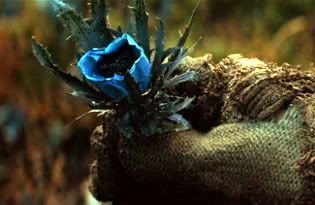
Kind of poppy-esque. After locating the flower Wayne must then climb Himalayan Mountains, a directive given by "Everest" narrator Neeson. Not only must he climb mountains, Bruce must also locate the monastery-like headquarters of the League of Shadows, a common element conferring a Shambhala metaphor. It's worth noting that all of this Orientalism is quite in step with the Romantic, Baroque, Gothic, Expressionist underpinnings of the Batman mythos.
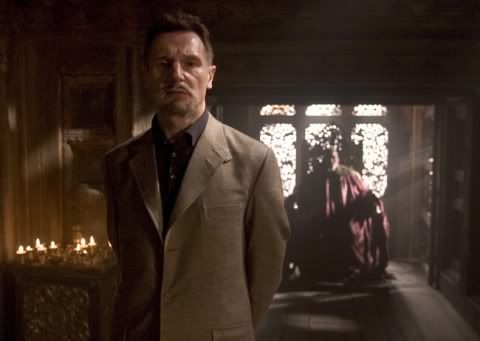
Bruce Wayne presents the blue flower to Ducard and the false Ra's al Ghul. This reinforces the repeating, multi-leveled symbolism of false doubles and alter-egos. Having passed the first stage of his initiation, Bruce's training by Ducard commences. It is a violent process, described as Bruce learning to face his fear in order to be able to manipulate the fears of others. Noting the allegorical use of violence in the super hero fantasy genre, we can always take interest in training of esoteric arts, martial and otherwise. Amongst the martial arts techniques identified by Ducard are the Dionysian symbols "Tiger'" and "Panther".
The exploration of Bruce Wayne's fears returns the story to his childhood, and his Fall down the Well. His father pulls him out and feeds him character-building advice on dealing with negative circumstances, words that become defining lessons for the soon to be orphaned Bruce Wayne.
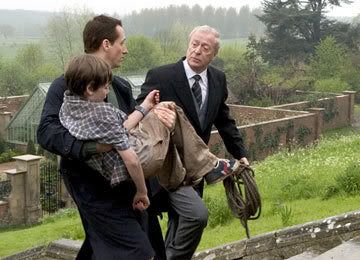
Thomas Wayne tells Bruce that, "We fall so we can learn to pick ourselves up", and that "All creatures feel fear", "Especially the scary ones". Thomas Wayne then shows Bruce a Pearl necklace he's bought for Bruce's mother, Martha. Noting that the Pearl is a goddess emblem, easily associated to Aphrodite, we can also take interest in the fact that the term "Baroque" derives from a term for imperfect Pearls (and Teeth). While the term may have been applied in a derogatory manner originally, we can delight in the evolution of its connotation, as a term now referring to the beauty of the irregular.
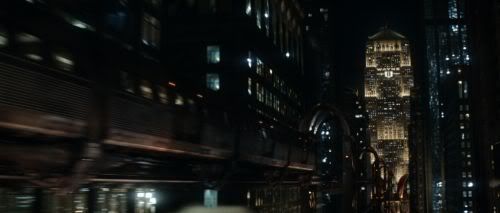
The most fateful night of Bruce Wayne's life is then presented, as he and his parents travel by Elevated Train to a night at the opera. The Train is a major emblem of being Ferried or Guided. An elevated Train then connotes a lifted or heightened teaching. This is emphasized on a story level as Thomas Wayne identifies the mass transit system as his philanthropic act for the city, establishing Thomas Wayne as the benefactor of Gotham City, one of many points where Bruce Wayne and Gotham City are eluded to being one and the same. The hub of the Train system is Wayne Tower (topped by a pyramid), described as the Center of Gotham City. Thomas Wayne, however, does not work at Wayne Enterprises. As a humanitarian, he had a calling to medicine, and works at the hospital. Thomas Wayne is a Hospitaller. Note the Deco/Gothic arches supporting Wayne's Train. Note too the Trident-like treatment of the "W" icon of Wayne Enterprises.
The family attends the opera, almost certainly a production of "Faust", but Bruce's recent trauma causes him to experience a phobic reaction to Bat-costumed performers hanging by ropes from the ceiling. He asks his father if they can leave, and they do, but this by happenstance causes them to be mugged by Joe Chill. Bruce's irrational fear, via coincidence, leads to the murder of his parents.
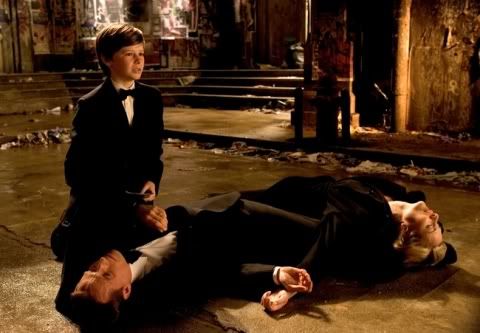
A highly religious scene, composed like a Baroque painting. Like most treatments of the Batman origin, emphasis is placed on the symbolic item of Martha Wayne's broken Pearl necklace. In the aftermath of his parents' murder young Bruce Wayne first meets James Gordon, and has significant interactions with Alfred and Rutger Hauer's character Mr. Earle. "Batman Begins" explicitly is about the shaping of Batman/Bruce Wayne via his various good and evil father-figures, Thomas Wayne, Alfred, Jim Gordon, Mr. Earle, Carmine Falcone, Ducard/Ra's al Ghul, and Lucius Fox.
Fear turns into guilt in the development of Batman's fundamental purpose. Time shifts forward again to Bruce's training with Ducard, where Bruce states that his anger outweighs his guilt. Bruce's training continues with emphasis on the art of becoming invisible through patience and agility, the use of theatricality and deception (the generation of a hoax), and the channeling of will into action.
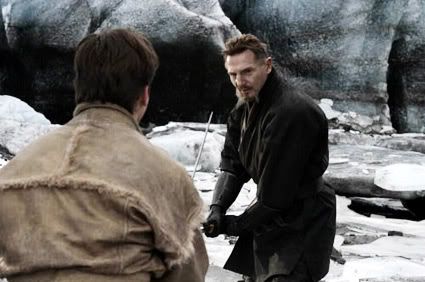
The duel on the frozen lake can be read in a number of ways, foremost of which I think is the continuation of the Luciferian symbolism associated with Ducard/Ra's. In "Dante's Inferno" the lowest level of Hell, the fourth zone of the ninth circle, is Judecca, reserved for traitors, frozen in ice. This is especially apt given the "multiple faces" of Ducard/Ra's. We can take interest in the reversal of directions at play here, the mountain climb as ascent to Hell.
We can see the symbol play involved in this continued "Fall" of Bruce Wayne as an active choice he makes, continuing the Faustian connotations, as the film flashes back again to the time prior to Bruce's self-imposed exile in the Orient. We learn he Dropped out of Princeton, demonstrating that his Fall is now a Jump, trying to move away from the aristocratic reality he was born to (but an inevitable aspect of his character that he eventually returns to). He even expresses his desire to have the mansion torn down.
In this sequence Bruce has returned to Gotham City to attend the parole hearing of Joe Chill, the man who murdered his parents. It includes his reunion with Rachel Dawes, who became an assistant to Gotham City District Attorney Carl Finch. Finch and Dawes are working to secure Chill's release as he spent time as a cell mate of Gotham crime lord Carmine Falcone, learning information, he agreed to testify against Falcone. The emphasis here on characters with Bird names is significant, indicating this work is speaking to us in the Language of the Birds, as we should fully expect from Batman, who is secretly a Bird-Man.
There is a palpable strain between the philosophical viewpoints of Bruce Wayne, angered and haunted by his personal loss, and his childhood friend Rachel, who represents at this moment the idealized intent of the justice system. In fact the emphasis placed by the filmmakers on the Bruce Wayne/Rachel Dawes relationship takes on new clarity if one considers Dawes as an allegorical representative of Justice. But Bruce at this time is focused on his personal crimes, and he attends Chill's hearing armed with a hand gun, prepared to avenge his parents despite the consequences of the action on himself. This becomes unnecessary as an assassin working for Falcone kills Chill immediately following the trial, preventing Chill from testifying. The fact that Falcone could get an agent close enough to Chill to do this further demonstrates the corruption of Gotham City, emblemized by Falcone.
Leaving the scene Bruce and Rachel debate the difference between justice and revenge. Bruce declares that the system is broken, and that the city is rotten. Rachel contends that the corruption represented by Falcone is generating dozens of criminals like Joe Chill every day, urging Bruce to switch his perspective from the micro to the macroscopic. He confesses to Rachel his plan to murder Chill himself, which infuriates and disgusts her. This leads to Bruce tossing his pistol into the river (visually establishing the loose Batman convention of not using firearms) and going to confront Falcone. The conversation between Wayne and Falcone is another key point of character development as Bruce Wayne is made to realize that his personal experience is a symptom of the larger disease of Gotham City, represented by Falcone. Bruce Wayne is Gotham City. Keeping to the movie's themes, Falcone stresses that his power is achieved through fear, stating "You always fear what you can't understand", a concept that feeds into Wayne's later construction of his theatrical persona, his symbol crafting.
Following this Bruce Wayne sets off on his journey to the East, renouncing his worldly goods and learning the criminal mindset (though it is stressed that he never truly becomes a proper criminal himself, as the goods he's arrested in China for stealing are the property of Wayne Enterprises). The film then returns to Bruce Wayne's League of Shadow training. Ducard uses a mortar and pestle (a symbol of witch craft/alchemy/the occult) to produce a powerful, fear-centered hallucinogen out of the initiatory blue flower (a property more or less shared by the blue flowers in Philip K. Dick's "A Scanner Darkly").
Ducard has Bruce inhale smoke from the blue flower, inhaling his fear. This is a clear demonstration of initiation by intoxication. This leads to a trippy ninja-fight exercise and Ducard presenting Bruce with a box containing his "worst fear", following the Pandora model. During this sequence Ducard delivers important concepts to the synthesis of the Batman figure, telling Bruce that, "To conquer fear you must become fear", to "Bask in the fear of other men.", that "Men fear most what they can not see", and that "Terror is the power to distort and control". Even more important is Ducard's instruction that Bruce become "-a terrible thought", "a wraith", "-an idea".
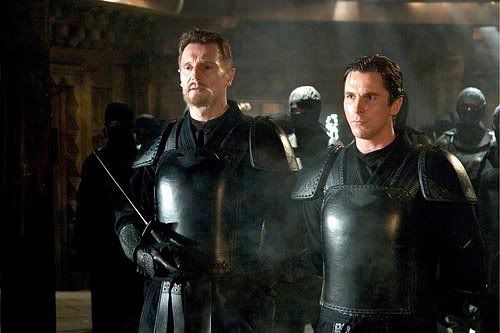
Bruce is then presented with the final level of his initiation, to become not just a member of the League of Shadows, but a field general, perhaps because Bruce Wayne/Batman is fundamentally an aristocrat, an aspect of his persona that he can not erase, a point made repeatedly through the movie, particularly by super-ego Alfred. But Bruce's final initiation is the execution of a criminal, something he refuses to do.
It is at this point that Bruce is made cognizant of the League of Shadows' plan to alter society by tearing down Gotham City. The most important function of the League of Shadows is described as inducing Change through calculated acts of destruction, crafting and perpetuating Hoaxes and False Flag actions. This is compared to the Fall of Rome. This becomes a pertinent statement by the filmmakers if we keep in mind that Gotham City, like Superman's Metropolis, is New York City, barely veiled and utilized as representative of larger American culture and society. Bruce Wayne, inherently connected to Gotham City, they are one and the same, recognizes that Gotham is rotten and needs transformation, but his mission is to Rescue the city, not tear it down or sacrifice it for some higher effect.

Now in opposition to the League, the conflict naturally becomes violent. Bruce Wayne engages in a duel with the false Ra's al Ghul, in the process setting the League of Shadows compound on fire, a symbolic device I'm sure we can all read easily. As the complex collapses around them the false Ra's is killed, but Bruce Wayne manages to rescue his personal mentor Ducard and escape the building before it explodes. He then saves Ducard again, stopping him from Falling off an icy cliff.
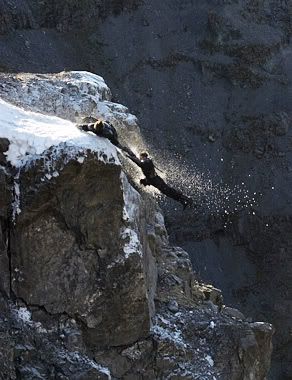
His training complete, and his ties to the League of Shadows now severed, Ra's al Ghul apparently destroyed, Bruce Wayne now decides to return to Gotham City, summoning Alfred to pick him up and bring him home. Because he can enter and exit the Underworld at Will. Alfred, clearly the conscious/super-ego/Jimminy Cricket of Batman in this telling, is significant here as the Wayne private jet pilots Bruce Wayne towards his mission to save Gotham City. Bruce and Alfred discuss how Thomas Wayne was a crusader against poverty. Bruce is following in his father's footsteps, but fighting different demons, corruption and depravity, the malicious feeding off the innocent, a Light and Dark struggle (Baroque) of Zoroastrian duality, a model of reality only available in allegories. Discussing the means of how he plans to fight his personal war, Bruce states "-people need dramatic examples to shake them out of apathy", and that as a symbol he can be incorruptible, showing his adoption of Ducard's lessons about crafting an idea or metaphor, perpetuating a hoax in order to effect social change. He furthers that this persona must be elemental and terrifying to be functional. We can take interest here in the emphasis placed on symbol crafting. The punning nature of an argotic symbol system often describes its own process.
We also learn here that Bruce Wayne has been declared legally dead (by Mr. Earle), as he has been missing for Seven years. The number seven connotes a complete time cycle (i.e. the days of the week, the Act of Creation), based on the geocentric planetary model. The resurrection motif is very easy to read here as Bruce Wayne is literally returning to Life after a full time-cycle in the Underworld. This is solar symbolism that is fully in step with the concept of Batman as Dionysus.
The typifying flash-back device of Nolan movies ends now as the story enters the present with a primarily linear narrative. We're introduced to Murphy's Dr. Jonathan Crane, testifying to the insanity of a Falcone hitman, resulting in the convict being sent to the Gotham City mental institution Arkham Asylum rather then going to prison. Batman fans might appreciate the inclusion of the fairly obscure Batman rogue Mr.Zsasz here. This is described as the third employee of Falcone that Crane has done this for, a situation that disturbs assistant DA Rachel Dawes, who accuses Crane of corruption. Note again the character name of Crane, said to be taken from Ichabod Crane from Washington Irving's "The Legend of Sleepy Hollow". The term "Gotham City" as a nickname for New York also originated with Washington Irving.
Back at the mansion, we see the "Batman Begins" version of the bat omen portion of the Batman origin. In this case the presence of the bat in the mansion is not a freak event, but a regular occurrence according to Alfred, and Bruce and the viewers know this is due to bat infested cave complex at the bottom of the well. The bat inspires Bruce, who has learned to conquer his fears, to climb down the Well (using ropes, his Descent and Ascent to and from the Underworld now controlled). Bruce pushes through the small opening (a clear rebirthing symbol) at the bottom of the Well from where the swarm of bats emerged years ago, and finds himself in a large cave complex with prominent Underground Stream. He lights a Torch, awakening the bat colony. His figure is lost amongst their swarm, but he is still, serene, meditative.
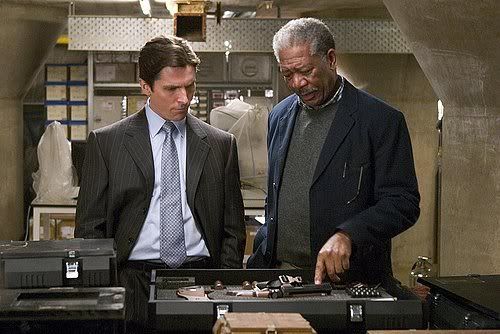
Returning from the dead at Wayne Enterprises, Bruce has a meeting with Freeman's character Lucius Fox (another import from the comic books, created by writer Len Wein, who also came up with Wolverine for Marvel comics). Lucius means Light, and having already noted that Mr. Fox shares a name with Batman inspirational figure Senior Zorro, we can see his Promethean nature in action as he allows Bruce Wayne to experiment with various high tech devices created by Wayne Enterprises for military application, including grappling equipment and light battle armor. Note that Lucius, a former Wayne Enterprises board member, has been exiled to the basement of the Tower and the archival department for dead projects. This not only presents a Promethean model, Fox is being punished for remaining loyal to the vision of Thomas Wayne, so by concern for the common people by proxy. As the source for Batman's gadgetry, we can further see a connotation of the Olympian craftsman god Hephaestus, another mythological entity associated with the productive application of fire, punished for his defiance with a Fall.

Bruce Wayne and Alfred now begin the process of creating the Batcave, demonstrated by the two bringing illumination to the subterranean complex. They also discuss plans for covertly importing the various components they will use to create Batman's costume and equipment. While this takes place Bruce Wayne is also surveying the situation in Gotham City. We're reintroduced to Oldman's Jim Gordon, one of the few honest cops on the Gotham City police force. His partner Arnold Flass is shown to be blatantly on the take from Falcone. Bruce, in ninja-like pre-Batman garb, contacts Gordon to recruit his assistance for his mission. Chased by the police, Bruce barely manages to escape, falling but catching himself on a fire escape.
In response to this close call he returns to Fox asking for lightweight fabrics for use in base jumping. Fox has "memory cloth", a substance that can be shaped using electrical currents. This provides a rational for the cape. At this point Fox also shows Bruce the "Tumbler", a high tech military vehicle designed to jump chasms and build Bridges during warfare. This of course becomes the Batmobile (never described as such).

Note the highly Casket like appearance of the Batmobile, the operation of which even necessitates lying in a prone position to fire missiles. An additional scene with Alfred in the Batcave finds the two finishing their crafting process. Bruce forges a bat shaped shuriken, reminiscent of the chipped arrowhead from the movie's opening scene, symbolizing his purposeful refinement into a living weapon.

Batman's first mission involves disrupting a major drug shipment by Falcone, with crooked cop Flass on scene. The drugs are smuggled inside Rabbit dolls, which I think is safe to assume is an Alice reference. Batman subdues Falcone (delivering the "I'm Batman!" line). The unconscious Falcone, self presented earlier as untouchable, is strapped to a spot light to produce the first Bat-Signal, as a message to the city of Gotham's new order. The signal light is easy to see as an emblem of Illumination, especially so presented in this context. Batman then saves Rachel from some Falcone thugs sent to shut her up, in the Subway, as always combining Train/Pilot and Underground symbolism. Batman provides Rachel with evidence he's gathered incriminating Falcone, and several corrupt members of the police force and the city government.

And the evening ends with a dramatic shot of Batman standing atop a spire, looking down on Gotham City, a shot utilized as one of the film's posters. Batman here is visually made one with the architecture of the city, he and Gotham are one of the same. Appropriately he is presented as a Column.

The imprisoned Falcone gets a consultation with Dr. Crane. Falcone states his awareness of Crane's experimentations with his patients, and threatens the security of their mutual employer's operation in Gotham, angling for a bigger payoff. Crane's response to this is to show Falcone his mask.
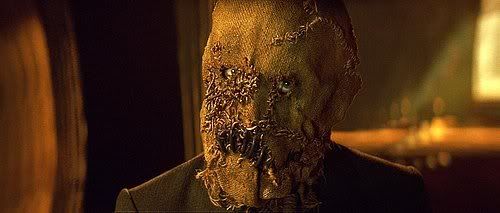
The important symbolic figure of the Scarecrow, found in so many fantasy works, is yet another representation of Dionysus, as shown in the Masopust celebrations, Czechoslovakia's Mardi Gras Carnivale. The Scarecrow, as the sacrificial, effigy form of the agricultural Dionysus, speaks easily to the many other solar-agricultural resurrection gods. Further there is the inherent relationship between Scarecrows and Crows. Scarecrow gases Falcone with his fear toxin, rapidly driving the mobster into a state of deep madness. This fear/intoxication attribute has been an aspect of the Batman Scarecrow character since the early Silver Age (the villain having appeared a hand full of times during the Golden Age without any such substance).
Batman captures and interrogates the crooked cop Flass and learns from him that there was something else hidden in the drug shipments, and that it was being sent to a building in the Narrows, a slum area of Gotham City, on an island, separate from the rest of the city, also the location of Arkham Asylum. Batman goes to investigate, and is on scene when Crane and his goons arrive to destroy the holding place. This is Batman's first encounter with a villain, appropriately a fellow Dionysus resonator, emphasizing the alter-ego symbolism. Underlining his initiatory nature the Scarecrow gasses/intoxicates Batman, and then sets him on fire. Batman, hallucinating wildly from the fear toxin, manages to escape, dose the flames and summon Alfred before becoming insensate.
He comes to two days later in his room at Wayne Manor. It is coincidentally Bruce Wayne's birthday, allowing for a minor resurrection reference, as he rises from near death on the day of his birth. Alfred had summoned Mr. Fox, who alchemically produced an antidote to the fear compound. Bruce recognizes the effects of the Scarecrow's toxin as being the same as that of the Blue flower used by the League of Shadows. Rachel visits the mansion to wish Bruce a happy birthday. Her gift to Bruce is returning the arrowhead.
At Wayne Enterprises Lucius Fox and Mr. Earle have a conversation about a top secret device stolen from the company that emits high frequency microwaves in order to vaporize water supplies or emit chemical agents into the air (the stolen device introduced earlier in the film, and the discovery of which led to the murder of Rachel's DA boss Finch). Earle then fires Fox for knowing too much information.
Rachel goes to Arkham to observe Falcone and confront Dr. Crane on the convenience of Falcone's sudden insanity plea. Falcone is insensate, able only to mutter "Scarecrow". Crane explains this as Falcone externalizing his inner conflicts onto symbolic forms, Jungian archetypes. Crane then leads Rachel to the basement of Arkham, revealing the operation to lace the Gotham water supply with the fear toxin. Rachel tries to escape, but can't operate the Elevator, and she's gassed by the Scarecrow with a heavy dose of the toxin. Batman arrives, a turn of events that seems to excite Crane. He has one of his men notify the police of Batman's presence at Arkham. In their second struggle Batman overpowers Crane and doses him with his own toxin.
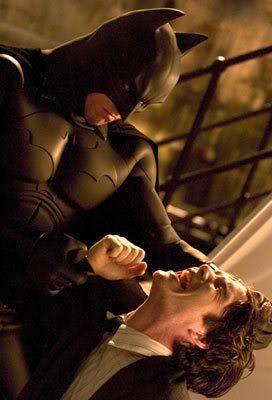
And then interrogates him. In his drug induced state Crane sees Batman as a cthonic demon with a viscous, black fluid dripping from his mouth. Crane tells Batman that he works for Ra's al Ghul, whom Batman believed to be dead. This is all the information Batman can get out of him however as Crane's mind fully snaps (the Scarecrow loses his brain). The police arrive and surround the Asylum. Batman removes Rachel from the basement.
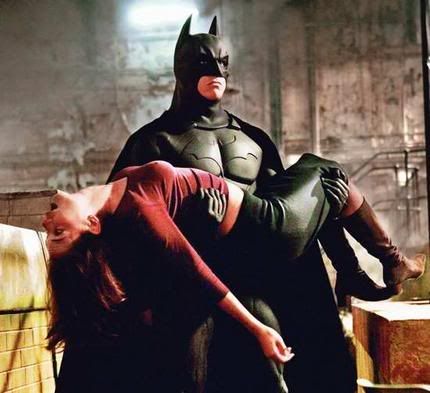
Afraid of Batman, the police wait for SWAT backup before entering the building. Jim Gordon runs in alone. Batman has his ally Gordon covertly carry Rachel out and instructs him to meet him in an alley nearby. He fills Gordon into Crane's operation to drug the city water supply. Batman then uses a hypersonic emitter to summon a bat colony to help cover his escape.
Outside he retrieves Rachel from Gordon and loads her into the Batmobile. The police closely pursue. At one point Batman drives up a spiral parking garage and then drives (flies) across the rooftops of Gotham City. As Rachel's sanity hangs in the balance he is extremely ruthless in avoiding the police. He manages to shake pursuit, and takes Rachel to the Batcave, entering through a hidden entrance behind a waterfall, a very clear Water Door to the Underground/Other World.
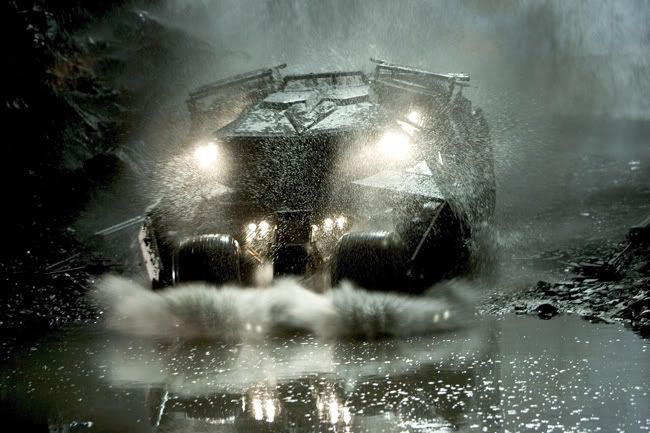
Batman gives Rachel the antidote and she awakens in the Batcave long enough (Batman casually informs her that he sedated her and she'll wake up at her home) for him to instruct her to take the two remaining doses to Gordon. He instructs Alfred to take Rachel home and switches to Bruce Wayne for a large birthday party being held for him at the mansion. At the party he meets up with Fox, who tells him about the stolen microwave emitter. Bruce sends Fox to Wayne Tower to generate more antidote.
He's then introduced by a guest to a Mr. Ra's al Ghul, another fake. But Henri Ducard is also present and Bruce now realizes that Ducard was Ra's all along. Naturally Ducard has also deduced that Bruce Wayne and Batman are one and the same. Recognizing the danger posed to the guests at his party Bruce play acts as a drunken cad, kicking everyone out. Ra's , in super villain fashion, describes his plot to Bruce, informing him that the fear toxin from the Blue flowers has been laced into the water supply, and will be vaporized by the microwave emitter, plunging the residents into terrified insanity, unleashing an "apocalypse of fear" on the city. He further suggests the ancient lineage of the League of Shadows, stating they have always been present to guide the course of society, maintaining balance by destroying corrupt cities, using "purging fire" to catalyze a "move back to harmony". The economic depression present in Gotham City during Bruce's childhood, the situation that resulted in the murder of Thomas and Martha Wayne and led to the high crime and corruption plaguing the city, is also identified as being orchestrated by the League. Ra's men then set the mansion on fire, as revenge for Bruce burning down the League of Shadows complex. Bruce is overpowered by Ra's men and becomes trapped under a collapsed, burning beam.
The League releases the inmates of Arkham Asylum, so the police move the majority of their men to the Narrows to round them up. Rachel revives and rushes to the Narrows, delivering the antidote to Gordon, but she becomes trapped on the island when the commissioner orders the bridges connecting the Narrows to the rest of Gotham raised. Ra's switches on the microwave emitter and the people in the Narrows go berserk.
Alfred rescues Bruce again and rushes him to the Batcave as Wayne Manor collapses behind them. He suits up as Batman and rushes to the Narrows. Rachel encounters Scarecrow, riding on a black horse (presumably liberated from a mounted riot police officer), presenting the Scarecrow as a kind of Sand Man riding a Night Mare (emphasized by the young boy Rachel is protecting who in his drug induced state sees the horse breathing fire).
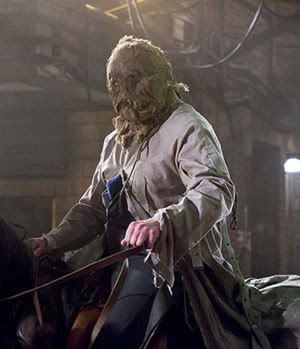
Rachel tazes Scarecrow, who gallops away shrieking like the Wicked Witch of the West, suggesting the reversal of this familiar figure, emphasized by his own use of fire. Rachel and the boy are then cornered by a group of Arkham inmates, including Mr. Zsasz, but they're rescued by Batman. He reveals his identity to Rachel, and then glides off to stop Ra's. The poisoned people below are depicted as seeing Batman flying over as a fire eyed demon. The hallucinatory device is here used to show Batman's synthesis, his metaphorical incarnation of fear, to be complete.
Ra's plan is to use the Gotham City elevated train system to transport the microwave emitter through the city, to the main hub of the city's water supply, of course beneath Wayne Tower, which will set off a chain reaction, vaporizing the laced water supply, spreading the madness now gripping the Narrows to the entire city. Despite the sombre, artsy trappings of the film we find here a very typical Batman-style villain's plot, a crisis on a clock, the mechanism of a closed system working with the logic of a Rube Goldberg device. After being mobbed by maddened citizens, Batman uses his Batrope to snag the speeding train, and he's dragged behind it as it races towards doomsday. If this were a hand of Tarot Major Arcana cards we'd have the Devil, the Chariot, the Hanged Man and the Tower.
Of course Batman gets on the train and of course it comes down to a final confrontation between him and Ra's, as the clock ticks away. Gordon races the train in the Batmobile, reaches a location directed to him by Batman and uses the Tumbler's missiles to shoot out the train supports, just in time. Note that the Everyman here really saves the day. The theatrical Batman is the distraction in this maneuver. As the train crashes Batman leaves Ra's to die, gliding away with his cape. Ra's goes down with the train, closing his eyes the moment before his death serenely, like a Jedi Master (which he is). No one familiar with the character of Ra's al Ghul can possibly view this as an actual death. Ra's al Ghul never dies. Resurrection is the primary storytelling motif of the character, notably present but not stressed in this production. Note the fiery aversion of the crisis, brought about by the collapsing of the Bridge, severing the connection to the Otherworld/Underworld, and forcing the Luciferian Ra's into a Fall. Lightning is prevented from striking the Tower.
This Fall is then echoed on another level as the next day, bright and sunny, it is revealed that Bruce Wayne retook control of Wayne Enterprises by buying up the majority share of the stock. Mr. Fox takes over and fires Mr. Earle. At the ruins of the mansion, Bruce Wayne boards up the Well he fell into years earlier, repeating the symbol of closing the Underworld. Rachel comes by and they kiss, as she now recognizes that he shares her mission to bring Justice through Order. But she closes the possibility of a romance for the time being, as she now recognizes that Bruce Wayne is the mask worn by Batman and not the other way around. Bruce Wayne is dead, and Gotham needs Batman.
With Alfred then Bruce announces his plan to rebuild the mansion brick for brick. Alfred suggests "improving the foundation", referring to the entrance from the mansion to the Batcave. Justice has instructed Batman to continue his mission, and the Underworld is immediately discussed as being reopened, with the passageway controlled, improved upon.
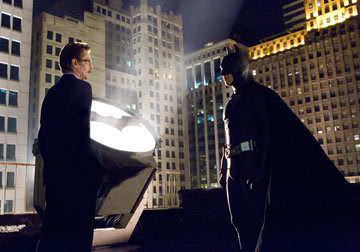
The movie then doesn't really end. It closes with Gordon debuting the proper Batsignal, the Illumination device. Their conversation is a recognition that things are going to get worse now, as Gordon worries about a kind of psychopathic arms race in response to Batman's theatrics. As an example he shows Batman the calling card of a new murderer, of course the joker card, overtly reminiscent of the Fool. Batman states he'll look into it. We can note that the act of Looking shapes the Batman character, and Seeing is key to his abilities, he Detects, he Unveils. He's a Hoax busting Hoaxes. But Everyman Gordon foresees that Batman might be channeling dark forces that are beyond control. For Batman to operate the door to the Underworld has to be open, that's where he lives, but when that door is open other things get out. Batman is the Initiator of this inevitable formula.
No comments:
Post a Comment